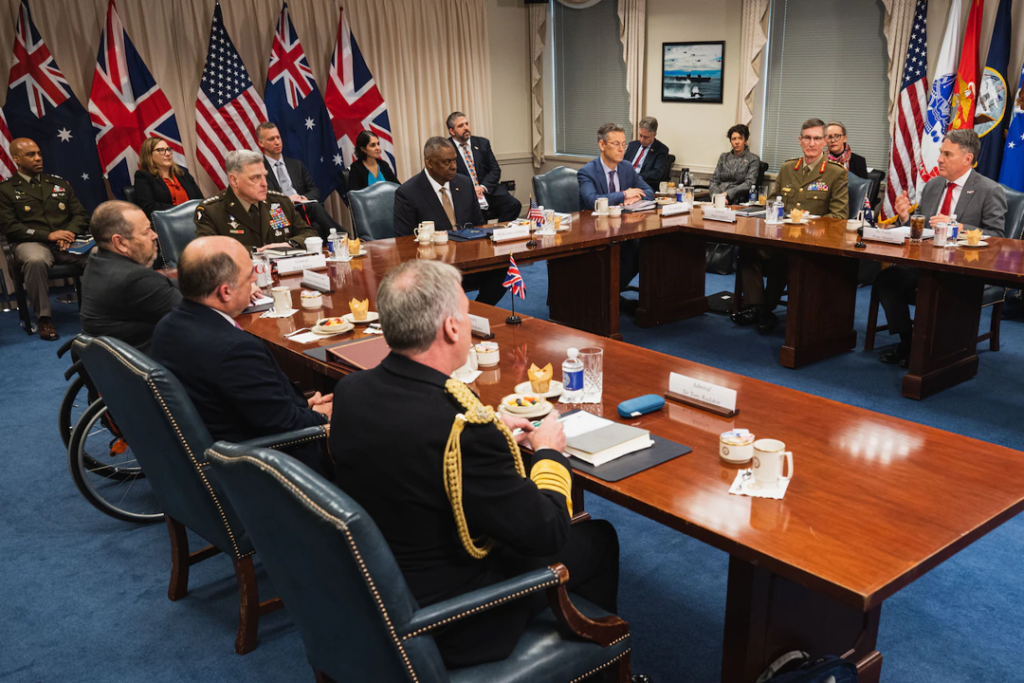Trilateral AUKUS Defense Ministers Meeting Held for the First Time
On 7 December, Australian Defense Minister Richard Marles and UK Defense Secretary Ben Wallace met with their US counterpart Secretary of Defense Lloyd Austin in Washington. This is the first time the AUKUS partners came together for cabinet-level talks; these are planned to be held annually going forward.
The AUKUS partnership was announced unexpectedly back in September last year with the primary aim of providing British and American nuclear reactor technology for Australia’s future nuclear submarine fleet. A secondary aim was to deepen cooperation in other areas of high-tech security research and development such as quantum computing, hypersonic and counter-hypersonic weapons, AI, and cyber. Overall, it was a significant step in deepening trilateral cooperation beyond the frameworks of ANZUS and the Five Eyes Partnership – US nuclear reactor technology is some of America’s most sensitive and closely guarded.
According to US Secretary of Defense Lloyd Austin:
“Over the past 15 months, we’ve made great progress toward identifying a pathway for Australia to acquire conventionally-armed and nuclear-powered submarines. Today, on behalf of President Biden, I want to reaffirm the U.S. commitment to ensuring that Australia acquires this capability at the earliest possible date and in adherence with the highest non-proliferation standards.”
A joint statement released following the meeting expressed great satisfaction with the progress on Australia’s nuclear submarine program and with AUKUS’s “extensive and productive engagement” with the International Atomic Energy Agency (IAEA). It then went on to highlight a number of other areas of R&D cooperation through the AUKUS framework, an Australian read out on the meeting said:
“The Secretaries and Deputy Prime Minister endorsed efforts to orient capability development to accelerate near-term delivery of technologies that will meet our militaries’ requirements to enhance capability and increase interoperability. These include initiatives for advanced trilateral maritime undersea intelligence, surveillance, and reconnaissance capabilities and use of each country’s autonomous systems to enhance maritime domain awareness. They further noted the role recent exercises have played in demonstrating and testing advanced capabilities, and approved plans to pursue additional demonstrations of several collaborative initiatives—including hypersonic and autonomous systems—in the 2023-2024 timeframe and beyond.”
Australian Defense Minister Marles traveled to Tokyo following the meeting where on 9 December, he declared that Japan should join AUKUS “when ready” and that all three members would be in favor of including Japan:
“My intent is to grow defense industry integration with Japan: bilaterally, through our trilateral mechanisms with the United States, and, when ready, via our advanced capabilities work in AUKUS as well. […] We have to focus on making sure [AUKUS is] actually starting to deliver but when it’s delivering, I absolutely think there’s a chance to involve Japan in the work we’re doing and I think that view is shared by both the UK and the US.”
The AUKUS partnership has had a rocky start having led to a major diplomatic crisis in which France recalled its ambassadors to Washington and Canberra and threatened to block EU-Australian trade talks. The French company Naval Group was working on non-nuclear submarines for Australia before the announcement, and while the termination of the partnership did not violate any formal agreements, it came as an unexpected shock to Paris. The alliance has also faced continuous criticism from Beijing – the clear target of both AUKUS and Australia’s naval buildup. Nevertheless, now in late 2022, the alliance seems to be on solid ground.

